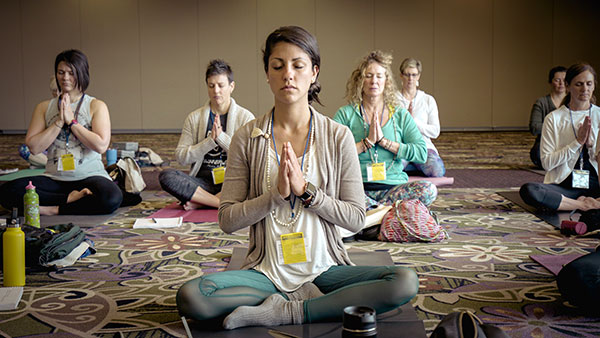 The velocity of our days are so intense, I bet there are times you barely remember when your next meeting is, let alone taking time out of your day to “stop and smell the roses”.
The velocity of our days are so intense, I bet there are times you barely remember when your next meeting is, let alone taking time out of your day to “stop and smell the roses”.
Workplaces today face increasing demands and challenges. High-stress levels may result in decreased effectiveness, creativity, and efficiency in employees, as well as in low workplace morale. Combined, these factors may lead to decreased productivity and increased employee absenteeism and burnout.
How Slowing Down Can Actually Be More Productive
Our default setting is switched to autopilot and we more often than not tend to immediately react to stimuli. Rarely do we take the time to pause and think about an appropriate response before we respond. But what if you took a minute to fire up those olfactory nerves and inhale a whiff of a rose every once in a while? Sounds (smells) peaceful, right?
Peace is the concept of harmony, the absence of hostility, the lack of conflict and freedom of fear. Can you think of the last time, if at all, you intentionally did something that brought you a sense of peace?
Not Just Another Productivity App
Meditation and mindfulness are tools that can be used to invoke a sense of peace within our lives and can lead your mind to think in healthier, less stressful ways.
Implementing these as tools in your workplace, different than the essential excel spreadsheets you strain your eyes on each day, help to counterbalance the challenges of information overload and the increasing demands of modern day office culture.

So what is meditation and mindfulness? While both are their own distinguished practice, meditation and mindfulness are completely synergistic and complimentary.
Mindfulness is…
a form of self-awareness, a state of being in the present moment and accepting things for what they are without judgment
While Meditation is…
a precise technique for resting the mind and attaining a state of consciousness that is totally different from the normal waking state.
Just as the practice of mindfulness enhances your ability to meditate, the practice of deep meditation strengthens your ability to be mindful.
In an eight-hour workday, the average worker is productive for only two hours and 53 minutes.
So, for almost one-third of our workday we preoccupy ourselves with unproductive activities, such as reading news, chatting with co-workers, checking social media, but not only that, we fail to have enough brain power to focus on completing one task at a time and are busy making mindless decisions that directly affect our productivity in the workplace.
Meditation and mindfulness go hand-in-hand, and the practice of one strengthens the other. But unlike other relaxation techniques, mindfulness can be developed to the point where it can be practiced right in the middle of stressful situations. While being mindful you can still remain alert and respond appropriately to the situation at hand, but without resorting to your autopilot and reacting. This can be extremely beneficial in a high intensity, fast-paced work setting where how you react to stressful situations can undoubtedly reflect on your job performance as a whole.
No Need to be Pro
What are ways you can begin to practice these techniques, you might ask? Well, you can start simple. The idea of creating a serene, stress-free work environment is virtually impossible unless you’re a Buddhist monk. So don’t stress yourself out even further with thinking you’re expected to achieve a state of complete nirvana. These practices are meant to help you cope with the day to day stresses and open your awareness to a different way of thinking and being.
Some simple and accessible steps you can begin to train your brain to be more mindful are:
- Breathe. The hectic nature of an office ensues with emails, pings, phone calls, all of which can seem overwhelming at times. When you arrive at your desk, practice having a moment or two without any distractions and envision your day. After completing a task, take a second to reward yourself with 3 deep breaths before moving onto the next one. When you’re in the elevator, focus on the rising and falling of your breathe instead of pulling out your phone.
- Re-familiarize yourself with the environment and the people around you. Allow yourself to enjoy a gaze out of the window or spark a conversation with a co-worker you haven’t connected with in a while. Your relationship with yourself and those around you will only strengthen as you feel engaged and connected
- Take a walk. Explore a new space in the office, get some fresh air. Walking can act as meditation, and by walking away from the desk, concentrating on your breathing, your focus, for example thinking about I need to open the door, I need to watch my feet walking up the stairs, I need to breathe while doing it. A simple walk will certainly do wonders for the body, mind, and soul and is a simple technique to introduce a mindfulness approach to the workforce.
- Get nimble. Yoga and stretching are perfect ways to get your blood flowing and the brain working. There are tremendous benefits to incorporating a yoga practice or quick stretch session in your work day, such as reducing stress, increasing energy levels, and alleviating physical ailments. Here are 7 yoga poses you can do right at your desk!
First things first. Simplifying your task list and tackle it one item at a time. Multitasking is the opposite of mindfulness and will deter you from performing at your highest level
- What is done is done. Instilling a mantra of concentrating on one thing at a time, allows for mistakes and forgetfulness to subside. Don’t beat yourself on what has already happened but rather learn from your mistakes and think about what you can do moving forward.
- Reflect on your achievements. Acknowledge the work you’ve done, and give yourself credit for it. Practice a loving-kindness towards yourself.
- Healthy fueling – let’s eat! (my personal favorite) Grab a healthy snack from your OMG box or shelf and give your body and mind the love it deserves!
- Guided Meditation Sessions. Organize twice daily, optional meditation sessions. Getting others involved with you will result in a calmer, happier team. You know that feeling when you have just finished something, taken a breath and feel great – and it’s suddenly disrupted by someone who has a fire-drill ready to place in your lap. Encourage those teammates to join you, so that emergencies can be addressed mindfully.
These are just some of the ways you can jumpstart a more mindful culture in your office. There are a plethora of other outlets one can use to study meditation and mindfulness. Apps on guided meditation and mindfulness, like my go-to, Headspace, or checking out our very own Justin Carl’s OMG blog post on four universal forms of meditation are extremely useful and accessible ways to help guide you and develop your new routine. You can take note from the world’s largest hedge fund and take your office to the next level by exploring Transcendental Meditation training for your employees. After digesting all that information, I think it’s time to meditate.
Namaste.
Learn more about Oh My Green and be sure to join our community on Facebook, Twitter, and Instagram. Find us as @OhMyGreenHQ.